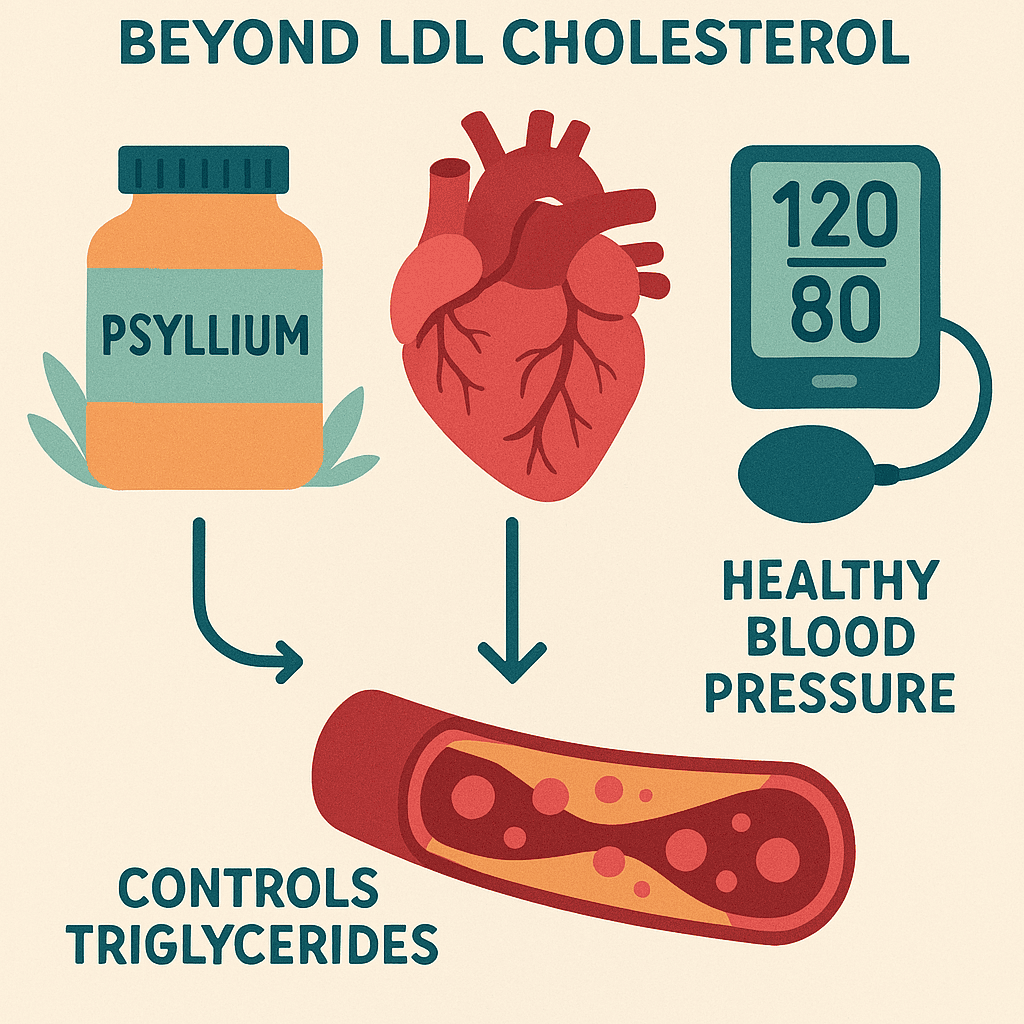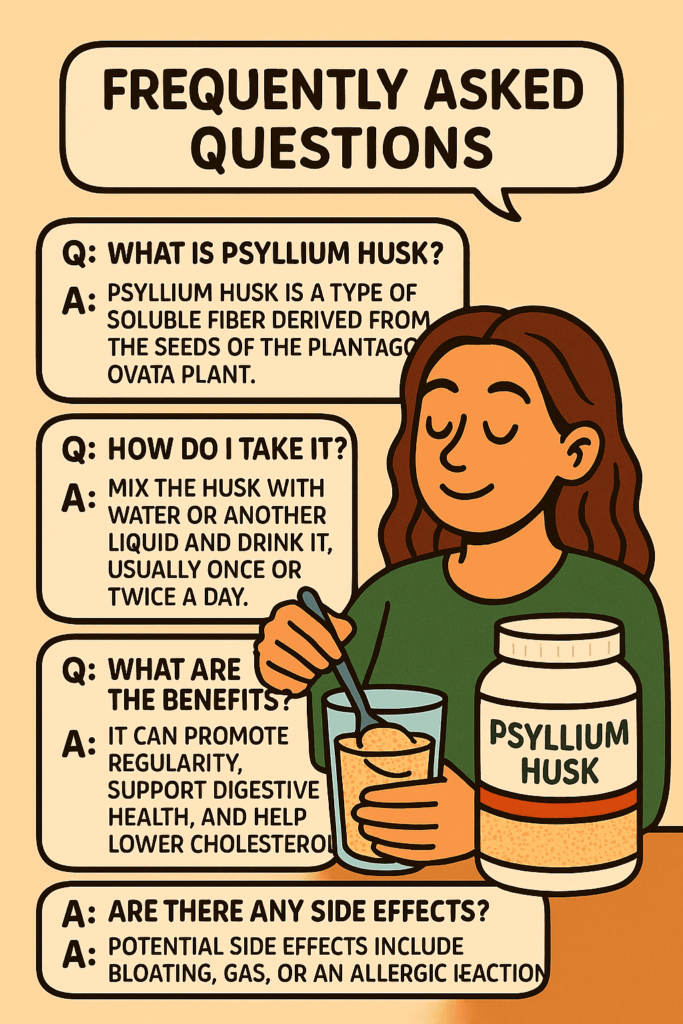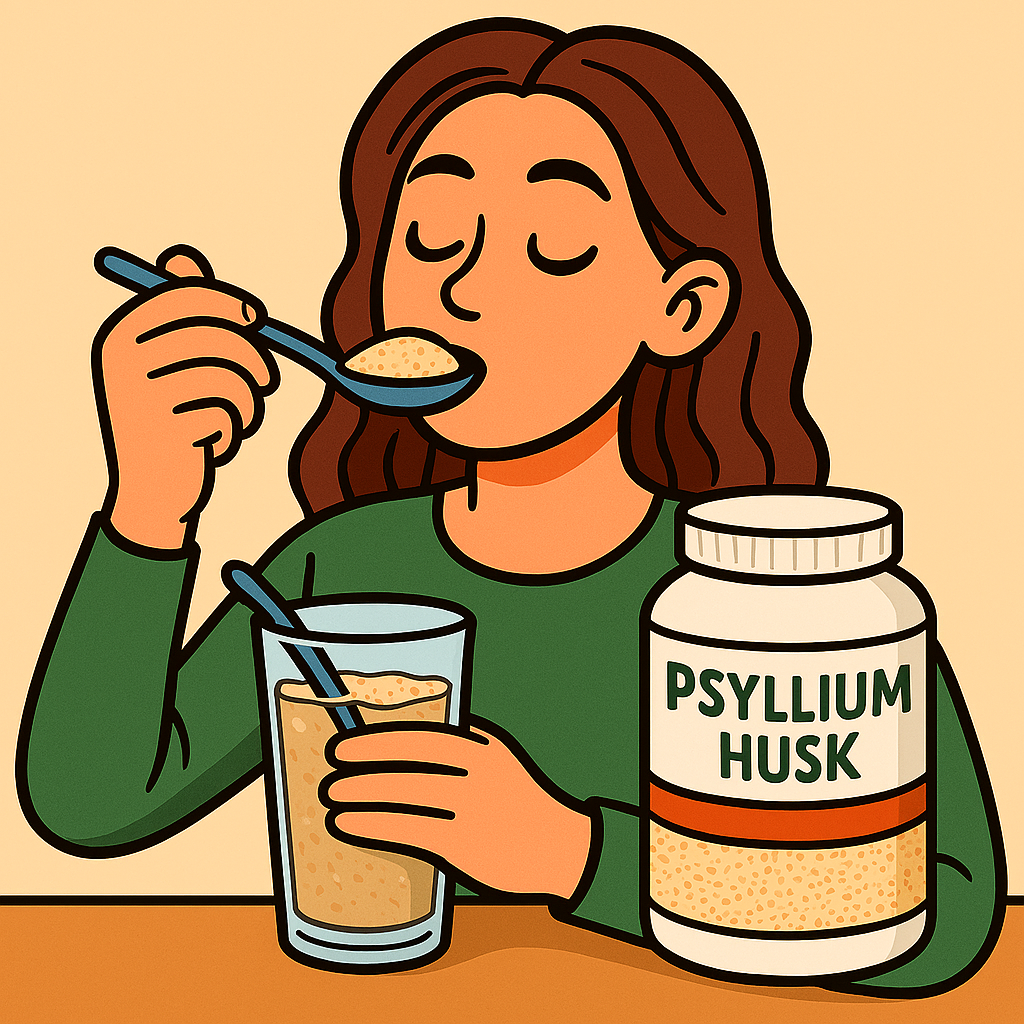Last Updated on August 17, 2025 by Irshad Quadri
Intro
Can Psyllium husk help to reduce cholesterol?
You must be wondering — does Can Psyllium husk help to reduce cholesterol really work? ✅ I will give a simple answer: Yes, research shows that psyllium helps lower LDL and total cholesterol, if you take the right dose and are consistent (Harvard Health).
Some context: Psyllium is a soluble fiber that forms a gel in water. This gel binds bile acids and some cholesterol molecules. Your liver needs cholesterol to make more bile, which can reduce blood LDL. This mechanism is simple and scientifically explained (PubMed Study).
People who are looking for natural ways – there are many searches with the name psyllium husk cholesterol benefits. Studies suggest 7–10g per day can produce measurable benefits, and in some trials LDL dropped significantly at 10 g/day. If used with a low-fat diet, the effect may be even better (Health Canada).
How psyllium lowers LDL cholesterol — short version: it traps bile and cholesterol in the gut, reduces reabsorption, and lowers LDL in the blood. This is a proven approach, and Health Canada and US labeling rules recognize it for certain health claims (US FDA).
Quick practical tip: If you’re just starting out, start with a small dose, drink more water, and discuss timing of medications with your doctor. Psyllium fiber for heart health is supportive, but a full heart-health plan requires diet and exercise.
Want examples from my site? Check my related posts for recipes and diet plans: Gluten-Free Cholesterol Lowering Foods and 7-Day Indian Meal Plan to Lower Cholesterol. These internal links will show you action steps.
Next step: Main will give you dosage guidelines, safety tips, and simple recipes, so you can easily add psyllium to your diet.

Table of Contents
What Science Says – Psyllium Husk Cholesterol Benefits
Psyllium Husk Cholesterol Benefits – Backed by Science
You might have heard that psyllium husk cholesterol benefits is a natural solution for many people ✅. This is not just a claim of health blogs, but science has also proved it. According to research, psyllium is a soluble fiber that forms a gel when mixed with water, and this gel binds cholesterol molecules and helps them pass out of the body (PubMed Research).
The US FDA has given psyllium an approved health claim that daily intake of 7g soluble fiber can help lower LDL cholesterol (US FDA Source). This means that if you take it on a regular basis, it can have a positive impact on your heart health. This approach is especially beneficial for people who are trying lifestyle changes along with or as an alternative to medicines.
One more interesting thing — soluble fiber not only reduces cholesterol, but also improves digestion and helps in sugar control (NCBI Study). So when you add psyllium to your diet, you are getting multiple health benefits at once.
If you need a simple idea to incorporate it into your diet, be sure to check out my blog post Gluten-Free Cholesterol Lowering Foods. There I have shared easy recipes and practical tips that are perfect for beginners.
Understand The Mechanism – How Psyllium Lowers LDL Cholesterol?
How Psyllium Lowers LDL Cholesterol – The Mechanism
You may be wondering how exactly the process of how psyllium lowers LDL cholesterol happens ✅. This is quite simple, and scientifically very logical too.
Psyllium is a gel-forming soluble fiber. When it is mixed with water, it forms a gel that traps bile acids in your intestine (NCBI Study).
The body needs cholesterol to make new bile acids. When old bile is trapped, the liver pulls cholesterol from the blood, which naturally lowers LDL cholesterol levels. This mechanism has been confirmed by many clinical trials (PubMed Research).
This approach may be a natural way to lower cholesterol without medicines, but diet and exercise also play an important role.
Infographic: See how psyllium traps bile acids and lowers LDL cholesterol.
Related read: Gluten-Free Cholesterol Lowering Foods for recipes that pair well with psyllium intake.
Psyllium Fiber for Heart Health

Psyllium Fiber for Heart Health – More Than Just Cholesterol
When we talk about psyllium fiber for heart health, people mostly focus on reducing LDL cholesterol. But the magic of psyllium does not end here! 💚
1. Supports Healthy Blood Pressure
Regular psyllium intake helps in keeping your blood pressure under control naturally. The sodium balance improves during the digestion process of fiber, which maintains BP.
2. Helps Control Triglycerides
The soluble fiber of psyllium supports fat metabolism in your liver, which reduces triglyceride levels. This directly reduces heart disease risk.
If you want to see more home remedies that control cholesterol naturally, then definitely read this blog: 5 Proven Home Remedies to Reduce Cholesterol Naturally

Psyllium Husk Dosage for Cholesterol
Psyllium Husk Dosage for Cholesterol Reduction
How much psyllium should I take? To reduce cholesterol!
Optimal Psyllium Husk Dosage for Cholesterol Control
What is the correct psyllium husk dosage for cholesterol control? Experts recommend taking 7-10g daily. This quantity covers 30% of your daily fiber needs. When taken regularly for 3-6 weeks, you’ll start seeing clear results.
✅ Simple calculation: 1 teaspoon psyllium husk powder = 5g fiber. So taking 1.5-2 tsp daily is perfect!
How to Take Psyllium: Smart Methods
Finding it difficult to swallow psyllium? Try these easy methods:
Water Method
Mix psyllium in a glass of cold water and drink it immediately. This prevents clumping and makes it easier to consume.
Smoothie Blend
Blend psyllium into your morning smoothie. The flavors mask the texture while adding valuable fiber to your breakfast.
Baking Ingredient
Mix psyllium into roti dough or baking flour. This creates healthy food that’s easy to incorporate into your meals.
Start with just 1 tsp (5g). Allow your body to adjust. Increase dosage slowly after 3-4 days. Remember: Drink an extra glass of water after taking psyllium to prevent constipation. Psyllium husk dosage for cholesterol is only effective when taken properly!
Timing and Consistency Matter
Start Phase
Days 1-3: 5g daily
Build Phase
Days 4-7: 7.5g daily
Maintain Phase
Week 2+: 10g daily
Results Phase
Weeks 3-6: Visible results
Is morning on an empty stomach best? Actually, taking psyllium with breakfast is more effective. You can also take it with lunch or dinner. Consistency is crucial – try to take it at the same time daily. If you miss a day, simply resume your routine the next day. Take it regularly for 6 weeks and you’ll notice improved cholesterol levels!
Important: Consult Your Doctor
Remember, every body is different. If you’re taking medications, discuss psyllium with your doctor first. In some cases, psyllium can interact with blood thinners. While psyllium husk dosage for cholesterol is generally safe, professional advice is essential. If you have diabetes, read my guide: Sugar Control with Natural Fibers.
Final Thought: Patience Pays Off!
Psyllium is a natural solution – it won’t work overnight magic. After 4 weeks, get a lipid profile test. You’ll see both triglycerides and LDL reduced! Bonus benefits include weight management and better digestion. A healthy heart means a happier life! Just remember to take it regularly and drink plenty of water. Start today!
Psyllium vs Other Fibers: Comprehensive Comparison
Psyllium vs Other Fibers
Which Wins the Crown for Cholesterol Control?
Are All Soluble Fibers the Same?
You might be thinking – “Fiber is fiber!” But this is not the case at all! There are clear differences between psyllium vs other fibers. Oat bran, flaxseed and guar gum are all soluble fibers, but each one has its own superpower.
Psyllium is the king when it comes to cholesterol control, and is also FDA-approved! ✅ Oats and flaxseed are also good, but they have to be eaten regularly. 1 tsp of psyllium = fiber equivalent to 2 bowls of oatmeal!
Oat Bran vs Psyllium: The Digestion Fight
Oat bran and psyllium both reduce LDL, but there is a difference in consistency. It is important to eat oat bran every day for breakfast. If you miss it, the cholesterol benefits are gone!
Psyllium? Mix in 5 minutes, drink it – whole day’s fiber sorted! Plus, psyllium vs other fibers has this winning point: Oats can contain gluten, while psyllium is 100% gluten-free. Perfect choice for allergy sufferers!
Flaxseed vs Psyllium: Omega-3 or Fiber Boost?
You must be a fan of flaxseed for omega-3, but compare the fiber content:
Flaxseed
- 1 tbsp = 2g soluble fiber
- Rich in Omega-3 fatty acids
- Must be ground for benefits
- Preparation required
Psyllium
- 1 tsp = 5g soluble fiber
- Seedless, no preparation needed
- Mixes instantly with water
- Quick and convenient
Can you mix both? Absolutely! But if you are targeting only cholesterol, then psyllium wins in psyllium vs other fibers.
Guar Gum and Inulin: Artificial Fiber Friends?
Processed fiber supplements are available in the market – guar gum, inulin powder, etc. These can cause digestion problems – bloating, gas! Psyllium is natural and research-backed for heart health.
Plus, their cholesterol impact is not as powerful. Natural psyllium has no side effects when taken correctly – just drink it with water!
The Ultimate Fiber Comparison
| Fiber Type | Soluble Fiber (per tbsp) | Cholesterol Impact | Convenience | Gluten-Free |
|---|---|---|---|---|
| Psyllium Husk | 5g | High (FDA approved) | Very High | Yes |
| Oat Bran | 2g | Moderate | Medium (cooking required) | No (usually) |
| Flaxseed | 2g | Moderate | Low (must grind) | Yes |
| Guar Gum | 4g | Low to Moderate | Medium | Yes |
| Inulin | 3g | Low | High | Yes |
Final Verdict: Who is the Boss of Cholesterol Control?
All fibers have their own benefits:
Pros
- Oat bran: Easy to incorporate into daily diet
- Flaxseed: Omega-3 bonus
- Psyllium: Heavyweight fiber champion!
Final score of Psyllium vs other fibers? Psyllium is the #1 choice of doctors for cholesterol reduction.
Time saving, more effective, and results are seen quickly.
Final Tip: Mix, but Smartly!
Take psyllium daily, but also try flaxseed or oats for a few days. Gut bacteria are happy with variety. But be careful – do not take more than 25g of fiber in a day. Start small, observe, then experiment. Heart is healthy, life is happy!
Safety, Side Effects & Who Should Avoid It
Psyllium Safety Guide
Side Effects, Precautions & Who Should Avoid It
Bloating and Gas? This is Temporary!
You may experience a little bloating or gas when you start taking psyllium – don’t worry! This is a normal reaction when the good bacteria in your gut changes.
Smart Approach
Start with 1/2 tsp and increase slowly. Drink minimum 2 glasses of water with psyllium! If discomfort continues after 2-3 days, slightly reduce the quantity. For Psyllium husk safety, give your body time to adjust.
Interaction With Medications? Yes, It Can Happen!
Taking psyllium with certain medications can be risky. Always consult your doctor if you’re taking:
Diabetes Medicines
Psyllium can suddenly reduce blood sugar levels when combined with diabetes medications.
Blood Thinners
Medications like warfarin may interact with psyllium, affecting their effectiveness.
Thyroid Medicines
Psyllium can interfere with the absorption of thyroid medications.
Depression Drugs
Certain antidepressants may have reduced effectiveness when taken with psyllium.
Medication Safety Tip
Take psyllium 1-2 hours before or after medications. This is the most important rule of Psyllium husk safety!
Who Should Avoid Psyllium? At-Risk Individuals
Some people should absolutely avoid psyllium or use it only under medical supervision:
- Those with a history of gut blockage or bowel obstruction
- Individuals showing symptoms of appendicitis
- Kidney disease patients
- Pregnant women (without doctor’s approval)
- Children without medical supervision
- Anyone with known psyllium allergy (throat swelling, rashes)
Water Is Your Safety Hero!
Psyllium’s biggest friend is water! This fiber expands 10-20 times in your gut. Insufficient hydration can cause:
Constipation
Without enough water, psyllium can cause rather than relieve constipation.
Throat Blockage
Improperly mixed psyllium can expand in the throat causing choking.
Stomach Pain
Dehydrated psyllium can cause cramping and abdominal discomfort.
Hydration Rule: Drink 8-10 glasses of water daily + 1 extra glass after taking psyllium. This is the golden key to Psyllium husk safety!
Emergency Signs: When to Call a Doctor
If you experience any of these symptoms, stop psyllium immediately and seek medical help:
- Severe, sudden abdominal pain
- Persistent vomiting or nausea
- Difficulty breathing or swallowing
- No bowel movement for 3 days
- Chest pain or tightness
These signs are rare, but being alert is essential. Even natural remedies can occasionally cause serious side effects.
Final Tip: Smart Use = Safe Use
Psyllium is a safe natural solution when used correctly:
Start low, go slow
Prioritize hydration
Consult your doctor
Listen to your body
If you have diabetes and want to take psyllium, see my guide: Diabetic-Friendly Fiber Sources.
Important Reminder
Every body is unique. What’s safe for a friend may cause problems for you. Psyllium husk safety first, results later!
How to Add Psyllium to a Cholesterol-Friendly Diet
Smart Ways to Add Psyllium to Cholesterol-Friendly Diet
Delicious Meal Ideas & Simple Recipes for Heart Health
Breakfast Power: Fiber Boost in the Morning!
Want to include psyllium in breakfast? It’s easy! All these options are perfect for psyllium for cholesterol control. Bonus: Stomach will also remain full till noon!
Overnight Oats
- Mix 1 tsp psyllium powder with oats
- Add milk or yogurt
- Top with fruits and nuts
- Refrigerate overnight
Poha/Upma Upgrade
- Mix psyllium with flour
- Use while preparing poha/upma
- Adds fiber without changing taste
- Keeps you full longer
Smoothie Booster
- Blend 1 tsp psyllium in smoothie
- Works with fruit or vegetable smoothies
- Thickens texture naturally
- Cholesterol-lowering benefits
Lunch/Dinner Hacks: With Roti and Rice!
How to make home food cholesterol-friendly? Try these tricks. Psyllium for cholesterol will become a part of the diet, without spoiling the taste!
Psyllium Roti
- Add 1 tsp to wheat flour
- Makes roti softer
- Increases fiber content
- Helps reduce cholesterol absorption
Rice Enhancement
- Sprinkle psyllium before cooking rice
- Mixes completely when cooked
- Doesn’t alter flavor
- Adds soluble fiber to every bite
Dal/Sabzi Boost
- Add to cooled dal or vegetables
- Stir well before serving
- Thickens gravies naturally
- Heart-healthy addition
Snack Attack: Healthy Munching with Psyllium
Evening cravings? Try these crunchy ideas. Ready in 5 minutes – heart healthy snacks!
Psyllium Laddoo
- Besan + ghee + sugar
- Add 1 tbsp psyllium
- Shape into small balls
- Fiber-rich sweet treat
Fiber Crackers
- Whole wheat flour + ajwain
- Add psyllium for fiber boost
- Bake until crisp
- Perfect with tea
Chaas Refreshment
- 1 glass chaas (buttermilk)
- Mix 1/2 tsp psyllium
- Stir well and drink immediately
- Cooling and healthy
Simple Recipe: Psyllium Roti (2 Servings)
Ingredients:
- 1 cup wheat flour
- 1 tsp psyllium husk powder
- 1/2 tsp ajwain (carom seeds)
- Salt to taste
- Water (slightly more than usual)
- Ghee for serving
Method:
- Mix all dry ingredients in a bowl
- Add water gradually to make soft dough (softer than regular roti dough)
- Let dough rest for 5 minutes
- Divide into equal portions and roll into rotis
- Cook on hot tawa until golden brown spots appear
- Apply ghee and serve hot
Tip: If you eat this roti then psyllium for cholesterol will help daily!
Secrets of Weekly Meal Plan
Confused in meal planning? Check out my detailed guide for a complete cholesterol-lowering strategy:
7-Day Indian Meal Plan to Lower CholesterolYou will find:
- Psyllium-rich breakfast ideas
- Traditional Indian dishes with fiber twist
- Restaurant-style recipes with homestyle health!
Pro Tip: Slow and Steady Wins the Race
Do not take Psyllium too much at once. Distribute it in different meals 1-2 times a day. Take it only in breakfast the first day. Add it to lunch next week. Body will adjust, side effects will be less. Remember – cholesterol is reduced only with consistency!
Final Thought: Healthy Heart, Happy Life!
Psyllium for cholesterol control is a smart choice. But it is only one part of a complete diet. Combine it with fresh fruits, vegetables and exercise. You will notice yourself in 6 weeks – energy will increase, belly fat will reduce, and cholesterol levels will improve! Start today!
Case Studies
Real-Life Case Studies ✅
Evidence from trials and real users showing how psyllium supports LDL reduction, triglyceride control, and overall heart health.
Brazilian Children & Adolescents (8 Weeks, RCT)
LDL ↓ ~10.7% and Total Cholesterol ↓ ~7.7%; well tolerated.
Adults (26 Weeks, Multicenter Trial)
Total Cholesterol ↓ 4.7% and LDL ↓ 6.7% vs placebo; sustained effect with diet therapy.
Pediatric Crossover Trial (6 Weeks)
Approximately 7% LDL reduction with good tolerance.
Adult Hypercholesterolemia (8 Weeks, Controlled)
Total Cholesterol ↓ 14.8% and LDL ↓ 20.2%; excellent adherence, no adverse effects reported.
Meta-analysis of Psyllium (≥8 Weeks)
Total Cholesterol ↓ ~4% and LDL ↓ ~7%; ApoB/ApoA-I ratio improved; safe and well tolerated.
Observational Tolerability (3 Weeks)
Total Cholesterol 252 → 239 mg/dL and LDL 174 → 162 mg/dL; early GI symptoms reduced with time.
Mechanism & Metabolic Effects (Review)
Explains how psyllium’s gel reduces bile acid reabsorption, supporting LDL reduction and glycemic control.
Real Users: LDL Drops with Psyllium
Multiple real-world anecdotes show notable LDL improvements over weeks to months when adding psyllium to diet.
FAQs

Psyllium & Cholesterol – Top 20 FAQs
These concise answers help your readers understand how psyllium fiber supports heart health, LDL reduction, blood pressure balance, and triglyceride control. Always consult a healthcare professional for personal advice.
1) What is psyllium husk?
2) Can psyllium help reduce cholesterol?
3) How does psyllium lower LDL cholesterol?
4) How long before I see results?
5) What’s an effective daily dose for cholesterol?
6) Does psyllium also help triglycerides?
7) Can psyllium support healthy blood pressure?
8) Is psyllium safe to take daily?
9) When is the best time to take psyllium?
10) Should I take psyllium before or after meals?
11) Can psyllium help with weight management?
12) What liquids can I mix psyllium with?
13) Are there side effects?
14) Who should avoid or be cautious with psyllium?
15) Can psyllium interact with medications?
16) Is psyllium gluten-free?
17) Can I cook or bake with psyllium?
18) What’s the difference between husk and powder?
19) Can children or older adults use psyllium?
20) What else should I do for heart health besides psyllium?
Conclusion
Conclusion – A Simple Step Towards Better Heart Health
- Recap: Psyllium helps reduce LDL cholesterol, improves digestion, and supports overall heart health.
- Dosage: Most studies suggest 5–10 grams daily, best taken with water.
- Encouragement: Start small, let your body adjust, and make it part of your daily routine.
Affiliate Disclosure
This blog contains affiliate links, meaning I may earn a small commission if you purchase through these links, at no extra cost to you. I only recommend products I trust and believe will benefit my readers. Your support helps keep this site running—thank you! 🙌

About the Author
Irshad Quadri is a Health & Wellness blogger who simplifies topics like cholesterol management, weight loss, and heart health for everyday readers. On iq4u81.blog, he shares science-backed diet tips, easy recipes, and practical guides to help people live healthier — without losing the joy of food.

